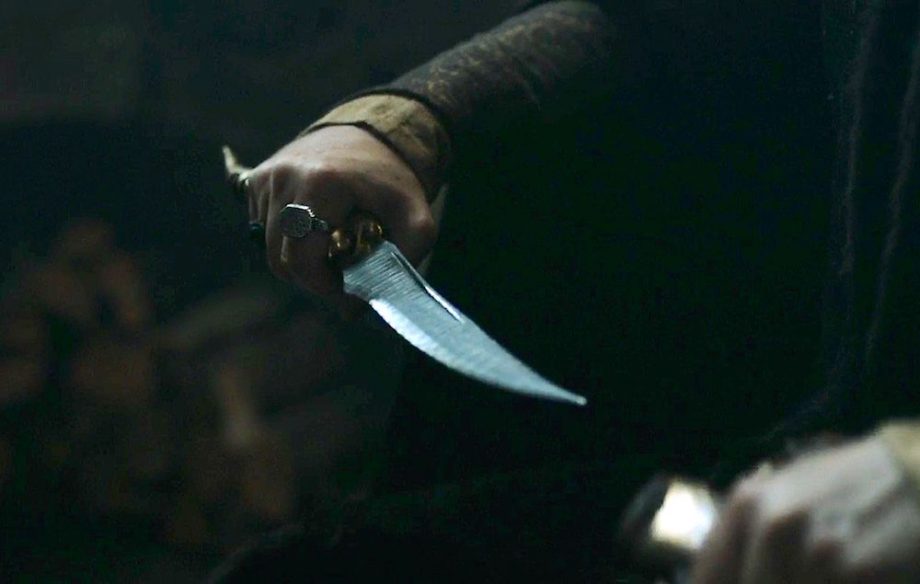How to Treat a Knife Wound
A knife wound doesn’t necessarily need to be terminal—unless it’s with Littlefinger/Arya’s dagger. Credit HBO/Press
Swords, spears, arrowheads, and, of course, Valyrian steel daggers are common causes of life-threatening hemorrhage and other injuries (like shattering into million little ice crystals and triggering the domino-like demise of all your undead friends, for example). Although acting quickly to control external bleeding can be lifesaving, some wounds cannot be controlled in the field. Prompt transportation to medical care or anywhere that isn’t literally swarming with your enemy is recommended.
1. Do not remove knives or other impaled objects.
The object may be lodged against a blood vessel and removal could increase bleeding.
2. Control the bleeding by using a combination of techniques.
DIRECT PRESSURE
Most bleeding from extremity or scalp wounds can be controlled using direct pressure. This is why you can watch battle heroes seemingly sustain countless slashes without faltering.
Apply pressure to the wound with gauze, cloth, or clean(ish) animal pelt and hold for several minutes.
Wear sterile gloves, if available.
Do not use direct pressure on the eye.
If an impaled object remains in the wound, apply pressure on either side without removing the object.
Direct pressure will not stop bleeding in the chest or abdomen; see WOUNDS TO THE CHEST for instructions.
LIMB ELEVATION
If the wound is in an extremity, elevate it above the heart to decrease pressure at the site and reduce bleeding.
If the victim is exhibiting signs of shock—decreased level of consciousness, rapid weak pulse, pale or clammy skin, fast shallow breathing—make sure they’re not actually a wight. If not, keep the victim flat with the extremity elevated.
PRESSURE POINTS
If direct pressure and elevation are not controlling the bleeding, apply pressure to the artery that supplies blood to the injured area.
The brachial artery supplies blood to the upper extremities. Compress the artery using firm pressure with two or three fingers on the pulse point just below the armpits on the inside of the upper arm.
The femoral artery supplies blood to the lower extremities. Compress the artery in the groin: feel for the pulse between the hip bone and the pubic area. Direct pressure to the bleeding site can be applied at the same time.
Check if bleeding in controlled. Slowly release your fingers from the artery while maintaining direct pressure on the bleeding site. If bleeding increases when pressure is lifted, you have found the right spot.
TOURNIQUETS
Place a belt or two-inch-wide band of cloth/fur around the injured extremity and tighten with a windlass (stick or other rigid object).
Place the tourniquet in the mid-portion of the upper at or leg. Larger victims may need two tourniquets, especially on the thigh.
For blast wounds, place the tourniquet as high on the arm or leg as possible, since shrapnel fragments can migrate up the arm or leg, away from the entry point.
3. Immobilize the injured area.
Use a splint to immobilize the extremity and protect it from further injury, and to maintain the clotting process. (Continuing to fight to the death is ill-advised—though it is a good way to go out a martyr or make a last grand-gesture of your eternal and unrequited love.)
4. Dress the wound.
Gently irrigate the injury with clean water, and then dress with clean cloth to prevent infection.
If available, a hemostatic powder or dressing (HemCon, QuickClot, Combat Gauze) will encourage blood clotting. Continue to apply pressure to the wound for five minutes after applying the hemostatic agent.
Wounds to the Chest
Open chest wounds—also called “sucking” chest wounds, because inhaled air enters the wound instead of the trachea (wind-pipe), resulting in a sucking sound—can occur from high-velocity projectiles that enter the chest and leave a whole nearly the same size as the trachea. If the chest wound is not sealed, the victim will suffocate.
1. Dry the area around the wound.
Tape will not stick to moist or blood-covered skin.
2. Wait for the victim to exhale.
Sealing the chest before the victim exhales may trap air in the space surrounding the lung and make breathing (more) difficult.
3. Wrap the victim’s chest.
Use any airtight (occlusive) plastic material such as plastic wrap, large plastic bag, or other airtight fabric to seal the wound. Secure the plastic on three sides with tape, allowing any air and blood to drain from the open sides of the dressing.
4. Monitor the victim’s breathing.
If breathing becomes more labored, lift dressing to release the air.
PRO TIP
During transport, roll the victim onto the uninjured side to allow blood to drain and the uninjured lung to breathe.

